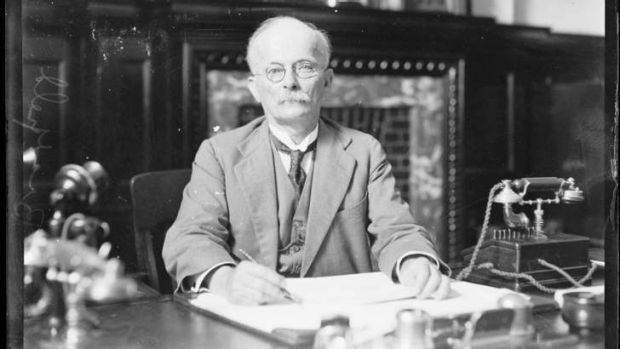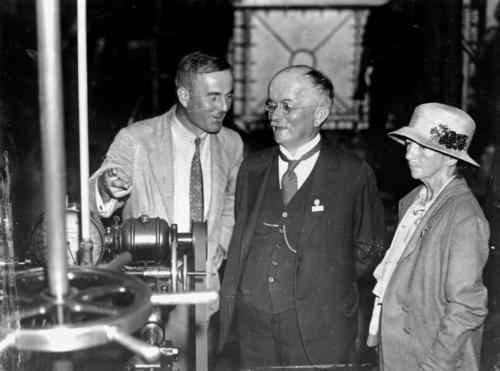Nationality Australian Role Engineer | Name John Bradfield Fields Engineering | |
 | ||
Died September 23, 1943, Sydney, Australia Education University of Sydney (1924), University of Sydney (1896), University of Sydney (1889), Ipswich Grammar School Similar People Ralph Freeman, Thomas S Tait, John Douglas Story | ||
Dr. John Jacob "Job" Crew Bradfield (26 December 1867 – 23 September 1943) was a prominent Australian engineer who is best known for his work overseeing the design and building of the Sydney Harbour Bridge.
Contents
- Personal life
- Education
- Professional career
- Sydney Harbour Bridge and Bradfield railway scheme
- Other works
- Significant projects
- Honours
- References

Personal life

Bradfield was born in Sandgate, Queensland, the youngest son of John Edward Bradfield (1823/4 – 1902) and Maria Crew (1828–1917).

He married Edith Jenkins, daughter of John Ventris Jenkins, in Brisbane on 28 May 1891. They had one daughter Mary Margaret (1892–1984) and five sons: Edward (born 1893), Anthony Bailey (1895–1974), Alan (1903), Stanley George (1906–1951), and Keith Noel Everal (1910–2006). Keith (known as Bill) Bradfield, an engineer with the Department of Civil Aviation, was responsible for changes to Alexandra Canal adjacent to Sydney Airport allowing the airport to expand between 1947 and 1970.

Bradfield died in Sydney on 23 September 1943. His wife Edith died in Sydney in 1954.
Education
He received his early education in Ipswich, Queensland where he attended Ipswich North State School [1] and Ipswich Grammar School. He then completed a Bachelor of Engineering in 1889 and then a Master of Engineering in 1896 from University of Sydney, where he was a resident of St. Andrew's College. He was a member of the Queenslanders' Association in Sydney. In 1924 Bradfield received the first doctor of science in engineering at the University of Sydney for his thesis on electric railways and the Sydney Harbour Bridge.
Professional career
From 1889 to 1891, Bradfield worked for the Queensland Railways Department as a draftsman. In 1891 he joined the New South Wales Public Works Department. In 1912 he was appointed Chief Engineer for metropolitan railway construction, when he commenced his long association with secretary Kathleen Muriel Butler. In 1915 Bradfield submitted a report outlining a grand scheme for Sydney's railways involving the electrification of the suburban railways, a city underground railway and the Sydney Harbour Bridge. World War I led to the collapse of all three proposals.
During World War I, Bradfield worked with Professor Warren and Mr A.E. Cutler to establish the first civil aviation school, where pilots were trained for overseas service.
Sydney Harbour Bridge and Bradfield railway scheme
It was not until 1922 that the Bridge Bill passed through Parliament. Much of his work on the Sydney Harbour Bridge involved the assistance of his secretary Kathleen Muriel Butler, who (despite her job title) was involved in the checking of specifications and the negotiations with tenderers.
The building of the bridge coincided with the construction of a system of underground railways in Sydney's Central business district, known today as the City Circle, and the bridge was designed with this in mind. The bridge was designed to carry four lanes of road traffic, flanked on each side by two railway tracks and a footpath. Both sets of rail tracks were linked into the underground Wynyard railway station on the south (city) side of the bridge by symmetrical ramps and tunnels. The eastern-side railway tracks were intended for use by a planned rail link to the Northern Beaches; in the interim they were used to carry trams from the North Shore into a terminal within Wynyard station, and when tram services were discontinued in 1958, they were converted into extra traffic lanes. The Bradfield Highway, which is the main roadway section of the bridge and its approaches, is named in honour of Bradfield's contribution to the bridge.
In 1923 the first sod was turned on the city railway. Bradfield had a grand vision for Sydney's railway system that has only been partly fulfilled. Bradfield's concept called for the construction of a network of underground city railway lines in association with the construction of the Sydney Harbour Bridge and a new rail terminal, Central. A larger network of lines was proposed for the western, eastern and southern suburbs however most of these lines remained concepts only and have never been constructed. The Depression, and later World War II, along with the growth of the motor car led to passenger numbers in Bradfield's plan being grossly overestimated. Parts of the city underground were constructed and exist as the present-day City Circle, with small sections built for the additional proposed city lines such as additional platforms at Wynyard and St James railway stations which have never been used for heavy rail transport. The underground city loop was constructed originally as a stub line to St James, and the line through Town Hall and Wynyard to the Harbour Bridge. It was not until 1955 that the loop was completed by the construction of Circular Quay station. A line to the eastern suburbs was eventually built, but along a different alignment to that envisaged by Bradfield, who proposed a line along Oxford Street.
Bradfield retired from the New South Wales Department of Public Works at the end of July 1933 after 42 years of service with the intention of continuing to work as a consulting engineer.
Other works
Bradfield was the designer and consulting engineer for the Story Bridge, Brisbane. He also designed the Cataract and Burrinjuck Dams.
In October 1938 Bradfield published a proposal (known as the Bradfield Scheme) for diverting some coastal rivers of Queensland onto the western side of the Great Dividing Range. However, it was never implemented. Bradfield designed the Circular Quay railway station. but it was not built until many years after his death.
Significant projects
A number of his works are listed on the Australian, New South Wales, and Queensland heritage registers:
Honours
Named in his honour are Bradfield highways in both Sydney and Brisbane, the Federal electorate of Bradfield, the North Shore Sewerage Bradfield Carrier in West Killara and Bradfield Senior College, a school for the creative industries in St Leonards. A footbridge in his home town of Ipswich, Queensland was named in his honour in 2010.
A Fellow of the Senate of the University of Sydney, Bradfield was awarded the Peter Nicol Russell Memorial Medal by the Institution of Engineers Australia, and appointed a Companion of the Order of St Michael and St George in 1933.
In 1934 he was awarded the Telford Medal by the Publications Committee of the Institution of Civil Engineers of London for his paper The Sydney Harbour Bridge, and its Approaches. In July 1936 the Institution of Civil Engineers in London elected Bradfield as a member of council representing Australia. In August 1940, a plaque was placed on the Story Bridge recognising the contributions of many of those involved, including Bradfield in Brisbane. He was awarded Queensland Institute of Engineers lifetime achievement award in 2007.
